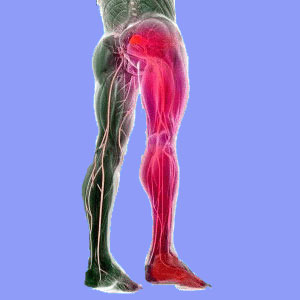
Sciatica pain can be a mere annoyance or a debilitating torture, depending on the location and severity of the symptoms. However, pain is just one of many possible expressions which might occur and some patients have terrible sciatica without any pain whatsoever. In some instances, patients only demonstrate neurological effects, which might include paresthesia in much of the lower body regions. Sciatica is one of the most prevalent back pain conditions and is estimated to affect up to half the adult population at some point in life. Sciatica is the most common form of symptomatic radiculopathy.
This resource section provides an overview of pain associated with sciatic nerve and pseudo-sciatica conditions. We will also detail a great number of specific sciatica pain syndromes in the dedicated article topics listed below.
Sciatica Pain Conditions
Sciatica is a greatly misunderstood condition. Most patients believe that it is normally caused by something pinching their actual sciatic nerve. However, this is virtually never the case.
The sciatic nerve is the main conduit of life energy to the lower limbs and contains nerve tissue which transmits motor and sensory signals between the legs and the brain, via the spine. It is also the largest nerve in the entire body. The sciatic nerve does not actually attach to the spinal cord directly. Instead, 5 pairs of spinal nerve roots converge to form the sciatic nerve in the pelvic region. These are the structures which can be compressed to elicit traditional sciatica symptoms.
Painful Sciatica Discussions
Sciatica pain is a multifaceted topic. We cover the subject in the following comprehensive essays:
Sciatica attacks might be occasional, random, patterned or frequent.
Sciatic nerve pain and sciatica muscle pain might be difficult to differentiate for any given patient. Both symptoms are horribly agonizing.
Sciatica and headaches seem like an unlikely symptomatic combination, but they do exist in some patients with singular or multiple causations.
Sciatica back pain describes pain in the lumbar region that often accompanies buttocks, leg or foot pain. Sciatica lower back pain does not always occur, even when leg symptoms are terrible.
Sciatica hip pain might occur when symptoms wrap around the side of the body.
Sciatica groin pain is one of the least common, but most miserable of all sciatica expressions.
Sciatica in the buttocks is one of the most universal of all symptoms.
Sciatica pelvic pain is another less common expression, often affecting women more than men.
Low back and buttocks pain is a classic combination of sciatica sufferings.
Shooting leg pain describes acute linear discomfort in one or both lower limbs.
Sciatica leg pain might affect one or both appendages throughout the entire leg or in select parts of the legs.
Sciatica knee pain might be one of the more disabling of all expressions in the legs.
Sciatica in the calf typically involves cramping and spasms of the muscle.
Sciatica shin pain is not a usual symptom, but can be very painful in some instances.
Sciatica foot pain can make standing, walking or physical exertion very uncomfortable.
Back and leg pain may or may not be derived from the same source process.
Back and foot pain may be mutually caused by a singular spinal issue or may have other possible explanations.
A painful sciatic nerve often becomes a chronic complaint that may endure for life.
Sciatic Nerve Pain Diagnosis
It is crucial to remember that sciatica is a symptom, not a condition unto itself. It is always created by a causative structural, disease-enacted or ischemic condition.
True sciatica must involve a spinal source, while pseudo-sciatica can be enacted by a great number of highly variable processes. Muscular and neurological testing can determine which nerve structures are being affected, but can not always accurately diagnose the actual cause of the symptoms. To determine the actual source of nerve involvement, an MRI or CT scan must be performed to visualize the spine. Even in these instances, many cases are still incorrectly diagnosed. They are typically blamed on coincidental abnormalities in the lumbar spine, while the real causative process remains unidentified. Sometimes, no evidence of structural abnormality may exist at all in the diagnostic findings.
Sciatica Pain Experiences
Sciatic nerve pain can be felt unilaterally on one side of the body or bilaterally on both sides. Pain may be patterned or unpredictable. The symptoms might be limited to pain, or may include other neurological expressions, such as tingling, in addition to actual or perceived weakness or numbness.
Sciatica is one of the most frustrating and treatment-resistant pain syndromes. It can be caused by a wide range of sources and many of these potential causations are some of the most misdiagnosed of all dorsalgia syndromes. Therefore, sciatica pain often becomes a chronic and sometimes lifelong struggle for the affected individual. It is not that most actual causations are incredibly difficult to cure, but instead, it is simply that the true source of pain is often not discovered for a very long time, if ever.
My Sciatica Journey
I was first diagnosed at age 16 with degenerative disc disease, scoliosis and muscle imbalances. I was also diagnosed with 2 herniated discs in my early 20’s. My very first back pain was a combination of acute lower back discomfort and sciatic nerve symptoms radiating into both legs.
My sciatica was a constant chameleon during the decades that I have endured horrific back pain. The symptoms would switch locations, severities and even actual expressions, ranging from pure blinding pain to tingling to definite muscular weakness and heaviness.
Eventually, my sciatica became one of the main chronic concerns which gave me a daily dose of pain. The symptoms were always there by the time I hit 30 and sometimes went acute in a fury of indescribable burning torment. This condition made my life a living hell and almost brought me to the edge of losing complete control over my own health.
In later years learned to handle my pain much better, especially since I learned the objective facts about sciatica and applied this knowledge to prevent doctors from blaming my suffering on any more innocent and coincidental structural irregularities. Decades of being focused on the lumbar region has cost me everything, when it seems the most logical contributory structural issues to my own pain exist in the mid and lower cervical spine. Regardless, I was able to cure my pain finally after a very long battle.
Read more about sciatica pain management.
Managing Sciatica Pain
In my extensive experience working with tens of thousands of back and neck pain patients over the years, sciatica is still the condition which causes the most confusion. The mythology surrounding sciatic nerve pain is extensive and the old tired stereotypes about the common causes and nature of the pain syndrome are well established, but mostly untrue.
All these factors make sciatica one of the most stubborn of all dorsopathy syndromes and are directly responsible for the literal epidemic of the condition which exists in our healthcare system today. Learn more about painful sciatica and why some patients have no pain at all, but still endure neurological effects.
All varieties of sciatica pain can be effectively managed and even cured using our proprietary Cure Back Pain Forever Program. Immediate help is available anytime, anywhere, including right now.






